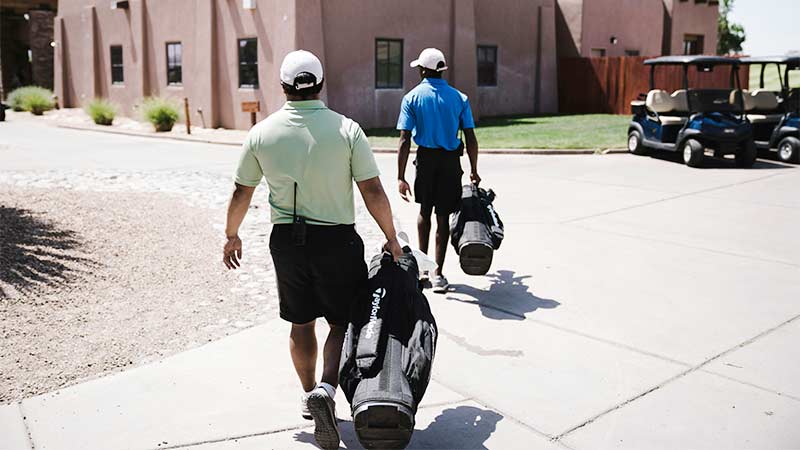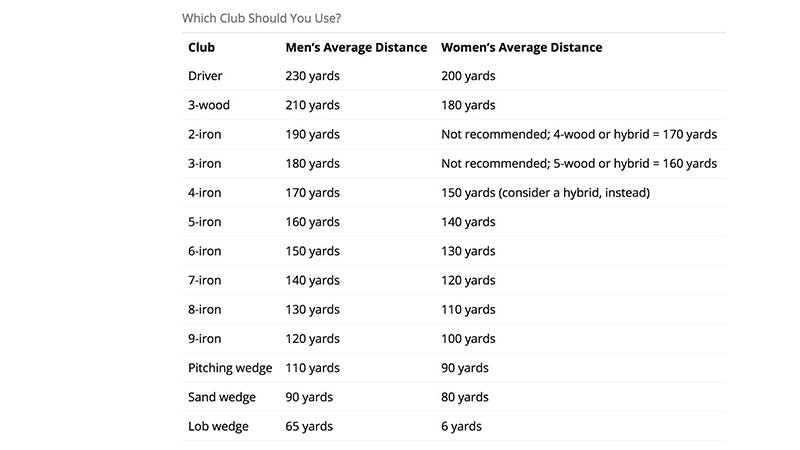Navigating the landscape of average golf club distances is a fundamental aspect of the game, shaping strategic decision-making on the course. Each swing, influenced by numerous variables, dictates the distance a golf ball travels.
Understanding the factors at play, from individual swing characteristics to equipment choices, empowers golfers to make informed decisions and enhance their overall performance.
In this dynamic realm of precision and power, exploring the average golf club distances is a key step toward mastering the art and science of the game.
Average Golf Club Distances Chart
Creating an average golf club distances chart requires specific data based on a golfer’s skill level and swing speed, and individual variations can be significant.
However, here is a generalized chart with approximate average distances for different golf clubs
| Golf Club | Average Distance | Description |
| Driver | 200-230 yards (Men) / 160-200 yards (Women) | The longest club in the bag, used off the tee for maximum distance. Distances can vary based on swing speed and skill level. |
| 3-Wood | 180-215 yards (Men) / 150-180 yards (Women) | Provides a balance of distance and control, often used off the fairway or tee on shorter holes. |
| 5-Wood/Hybrid | 170-200 yards (Men) / 140-170 yards (Women) | A versatile club for fairway shots or longer approach shots. Hybrid options offer forgiveness and ease of use. |
| 4-Iron | 160-190 yards (Men) / 130-160 yards (Women) | Used for longer approach shots from the fairway. Requires a more precise swing due to the lower loft. |
| 6-Iron | 150-180 yards (Men) / 120-150 yards (Women) | A mid-iron used for various approach shots. Offers a good balance of distance and forgiveness. |
| 8-Iron | 130-160 yards (Men) / 100-130 yards (Women) | Typically used for shorter approach shots, providing loft and control. |
| Pitching Wedge | 110-140 yards (Men) / 80-110 yards (Women) | Primarily used for approach shots around the green. Offers high loft for better control. |
| Sand Wedge | 90-110 yards (Men) / 70-90 yards (Women) | Designed for shots out of bunkers or soft lies around the green. Offers high loft and increased spin. |
Note These are general averages, and actual distances can vary based on factors such as individual swing characteristics, equipment, and course conditions. Golfers are encouraged to track their own performance for more accurate data.
Average Driver Distance By Age

Creating an average driver distance chart by age involves various factors, including skill level, fitness, and equipment. However, here’s a generalized chart based on common trends.
It’s important to note that these are rough estimates, and individual variations are significant
| Age Group | Average Driver Distance | Description |
| 20-29 | 240-300 yards | Typically, golfers in their 20s may have more strength and swing speed, resulting in longer average driver distances. |
| 30-39 | 230-280 yards | As golfers progress through their 30s, there may be a slight decrease in average driver distance due to various factors. |
| 40-49 | 220-270 yards | Physical changes and potential alterations in swing speed may contribute to a moderate decline in average distances. |
| 50-59 | 200-250 yards | Aging may lead to reduced swing speed and overall distance, but skill and technique can still play a significant role. |
| 60+ | 180-220 yards | Generally, golfers over 60 may experience further declines in distance due to factors like decreased strength and flexibility. |
Note Individual performance can vary, and these averages are based on general trends. Golfers are encouraged to focus on overall game improvement rather than strictly adhering to age-related averages.
What Things Have Impacts On Average Golf Club Distances?
The average golf club distances can be influenced by a multitude of factors, making it crucial for golfers to understand these variables for more accurate shot planning.
From individual swing characteristics to external conditions, here are seven key elements that impact average golf club distances
Swing Speed
The golfer’s swing speed is a primary determinant of distance. A faster swing speed generally results in greater ball velocity, leading to longer distances. Regularly assessing and working to improve swing speed can positively impact overall performance.
Skill Level
A golfer’s proficiency directly affects club distances. Skilled players can optimize their swing mechanics to achieve more consistent and efficient strikes, translating into increased distance compared to less experienced counterparts.
Equipment Quality
The type and quality of golf clubs significantly influence distances. Modern club designs, materials, and technology can enhance performance. Custom-fitted clubs tailored to a golfer’s specifications can lead to more accurate and powerful shots.
Club Selection
Choosing the right club for a specific shot is crucial. Each club has a distinct loft and design, impacting trajectory and distance. Proper club selection based on the situation contributes to more effective shots.
Course Conditions
External factors like weather, elevation changes, and course conditions play a pivotal role. Wind speed and direction, temperature, and altitude can all influence how the ball travels through the air, affecting overall distances.
Physical Fitness
The golfer’s physical condition, including strength, flexibility, and overall fitness, directly contributes to swing power and efficiency. Improving physical fitness can positively impact club distances by optimizing the body’s ability to generate power.
Mental Factors
The mental aspect of the game is often underestimated. Confidence, focus, and course management skills can influence shot execution.
A golfer’s mental state can impact swing mechanics and, consequently, the distances achieved with each club.
Understanding and actively addressing these factors empowers golfers to fine-tune their game and achieve more consistent and effective distances across various clubs.
Continuous evaluation and adjustments in these areas contribute to improved overall performance on the golf course.
Conclusion
Unraveling the intricacies of average golf club distances unveils a tapestry woven with skill, technology, and environmental factors.
From the nuanced impact of swing speed to the crucial role of equipment quality and course conditions, golfers navigate a landscape where every decision influences the outcome of their shots.
Embracing the complexity of average distances fosters a deeper appreciation for the dynamic interplay between the golfer and the game.
By continually refining skills, leveraging technology, and adapting to various conditions, golfers can elevate their understanding and execution, leading to more consistent and satisfying outcomes on the fairways and greens.








Colin McCarthy